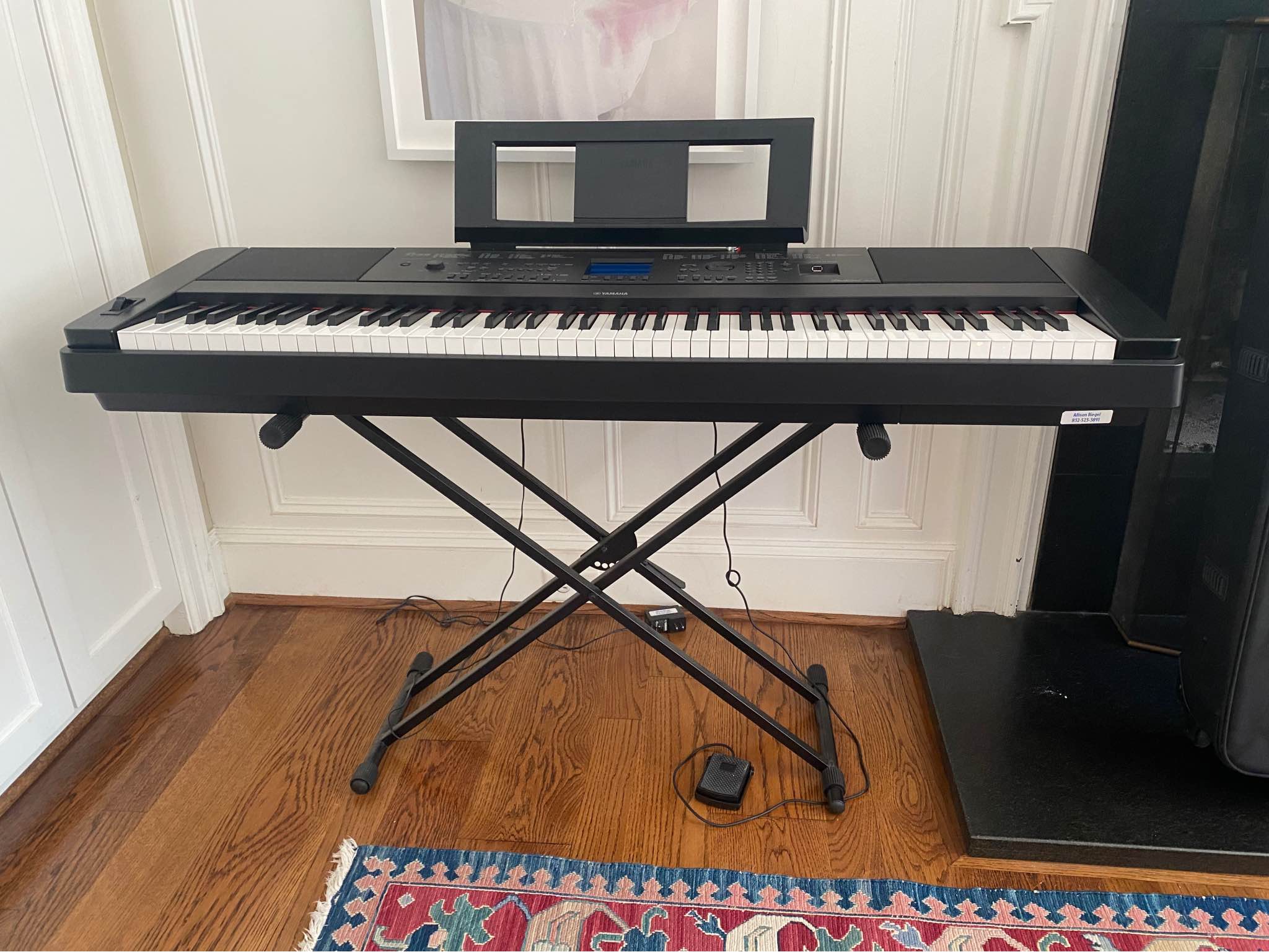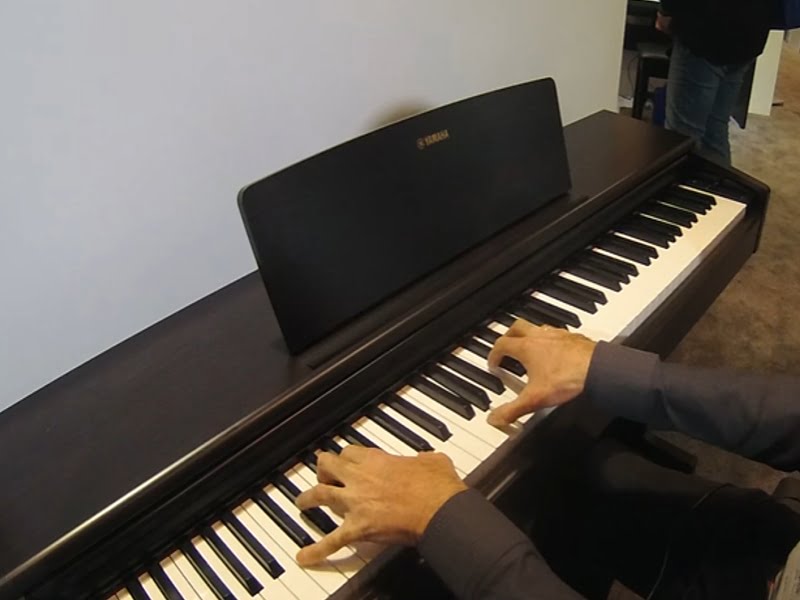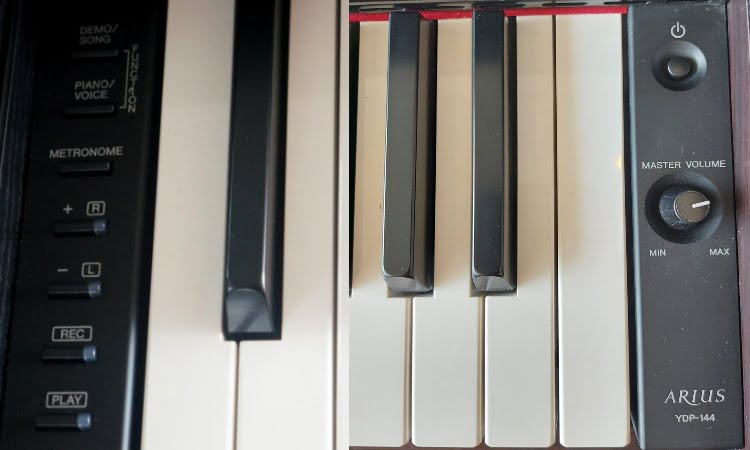Find out everything you need to know about these two pianos and which is the best pick in this Yamaha DGX-660 vs YDP-144 review.
The Yamaha DGX-660 and the YDP-144 are two digital pianos that I really love. They are both great pianos that come with various features and come from a very reliable brand.
And for many pianists, finding the best digital piano is a matter of comparing the Yamaha DGX-660 vs the YDP-144 and going for whichever piano wins this comparison.
When I tested and compared these two pianos myself, I found that the Yamaha DGX-660 has a slight advantage. Even if it doesn’t have the newest sound engine from Yamaha, it comes with great tones, a realistic feel, and a wide range of voices.
However, you might find the YDP-144 a bit more useful, depending on your needs. That’s why I’ll dive into the features of both models in the comparison below so that you can learn the pros and cons of the pianos and choose the best one for your needs and preferences!
Yamaha DGX-660 vs YDP-144: Comparison Chart




Last update on 2025-04-17 / Affiliate links / Images from Amazon Product Advertising API
Yamaha DGX-660 vs YDP-144: A Head-to-Head Comparison
There are always three main features I consider when comparing digital pianos. These are the tone, feel, and polyphony. These features are arguably the most important and defining characteristics of a digital piano and are things that you shouldn’t overlook when buying one for yourself.
And after all was said and done, the score was 3-2 in favor of the Yamaha DGX-660. These pianos were tied in almost every category. But because the Yamaha DGX-660 offers a more flexible and varied sound library, it ended up winning.
Tone
The winner: Yamaha DGX-660
The first feature I looked at was the tone. It’s very important to get your hands on a digital piano that has good tones. And between these two options, I couldn’t pick a winner when for tone quality. But since the Yamaha DGX-660 has a much wider and more varied sound library, it ended up taking the point.

+Tone Generation
Between these two pianos, the YDP-144 has the more advanced tone engine. The YDP-144 comes with the Yamaha CFX engine, which is one of the newest options on the market. It is the immediate successor to the tone engine on the Yamaha DGX-660, which is the Pure CF Sound Engine.
That said, I could barely hear a difference between these two engines. This is because both generators derive their sound from recordings of Yamaha CF Grand Pianos. This is why you get very crisp, bright, and realistic piano tones from either instrument.
While there is a bit more clarity and detail in the sounds of the YDP-144, the difference was almost too small to hear. I found that both pianos produce some of the most realistic tones in their prince range.
However, the Yamaha YDP-144 is way more expensive than the DGX-660. So, I was expecting a bit more of a difference in their tone quality. But since these pianos are so close in tone quality, I don’t think the YDP-144 is worth the extra investment.
+Sound Library
The main reason I gave the point to the DGX-660 was the fact that it has a much wider sound library. The DGX-660 is designed for musicians that play many different genres, while the YDP-144 is designed for people who only really need piano, strings, organ, and bass voices.
While all the voices on the YDP-144 are top quality, there’s no denying the versatility and flexibility of the DGX-660. With over 550 voices, the DGX-660 allows you to play virtually any genre or musical style out there.
That said, while you get more versatility with the DGX-660, keep in mind that not all the tones use the Pure CF Sound Engine. So, when you get to some of the more unique voices like drums, synths, or guitars, you may not be getting the same sound quality. That said, it’s important to have many options when playing different genres, which is why I would recommend the DGX-660 over the YDP-144.
Feel
The winner: Tie
The next comparison point was the feel. When buying a digital piano, it’s important to find models that have a realistic feel. And since these pianos come from the same brand and sport the same hammer action system, I couldn’t pick a winner between the two. So, both pianos ended up with a point for this category.

+Hammer Action
If you’re looking for a realistic weight with your digital piano, both the DGX-660 and YDP-144 are good options. This is because they support the Yamaha Graded Hammer Standard or GHS, which is largely considered one of the best options in its price range. This is because the GHS provides a very realistic feel and weight, capturing the subtle differences in the weight of certain keys of the piano.
So, you will find that the lower keys are significantly heavier than, the higher piano keys, which adds a subtle, but important layer of realism. I was really satisfied with the weight on both of these pianos, so there are no complaints in that regard.
That said, the key texture of these pianos posed a slight issue. This is because both pianos have plastic keys with a coating only on the black keys. This means that you will instantly feel the textural difference between these keys and those on a real acoustic piano.
This wasn’t that big of an issue for the DGX-660, as it’s the more affordable option. However, I was disappointed that the YDP-144 didn’t come with textured keys, especially considering that it’s the more expensive option.
Polyphony
The winner: Tie
The last comparison point for these two pianos was the polyphony. This refers to how many notes the piano can play simultaneously. But when comparing the two pianos, I couldn’t select a winner as they both come with the exact same polyphony.
Both pianos are able to play 192 notes at the same time. Since they both have 192-note polyphony, you can be very expressive in your playing, let dense chords ring out, and experiment with the various playing modes on both instruments.
That said, it would have been great to see 256-note polyphony on the YDP-144. Most digital pianos in the YDP-144’s price range nowadays have 256-note polyphony. And while this isn’t a big deal, it’s definitely something worth noting.

Yamaha DGX-660 vs YDP-144: The Similarities
These pianos share a fair amount of similarities. Since they come from the same brand, you can expect them to have a couple of similar features. For example, I just talked about how they have the same hammer action system and polyphony. But as you’re about to learn, the similarities don’t end there.
On top of all of the things I mentioned earlier, both pianos have split, dual, and lesson modes. These are widely considered the essential playing modes for any digital piano and unlock many possibilities for pianists. So, if you’re looking for a digital piano that offers many playing modes, both options would be a good pick.
That said, the YDP-144 is significantly more expensive than the DGX-660 and doesn’t offer that many additional features. So, if you want the best value for the money, you might want to go with the DGX-660.
Quick Rundown of the Yamaha DGX-660
- The Pure CF Sound Engine faithfully reproduces the tone of a meticulously sampled and highly acclaimed Yamaha concert grand piano
- GHS weighted action is heavier in the low register and lighter in the high, just like an acoustic piano
- Score display puts music notation of MIDI songs on the screen, helping you play your favorites by following the bouncing ball
- The Piano room lets you choose from a variety of pianos and acoustic settings to create your own personal piano environment
- The 6 track recorder allows you to capture your performances and song ideas, then add additional layers to spice up your pieces
Last update on 2025-04-17 / Affiliate links / Images from Amazon Product Advertising API
Quick Rundown of the Yamaha YDP-144
- Your purchase includes One Yamaha Arius Series, YDP144 model | Bench, 50 Classical Music Masterpieces Book, Owner’s manual & Quick Operation Guide
- Piano dimensions – 53-7/16” W x 32-1/16” H x 16-5/8” | Weight – 83 lbs. | Number of pedals – 3 | Max polyphony – 192 | Number of voices – 10 | Headphones – (2) Standard Stereo phone jack | With Recording and Playback capabilities
- GHS weighted action is heavier in the low keys and lighter in the high keys, just like an acoustic piano
- Half-damper pedal control allows for continuously increasing amounts of sustain as the pedal is depressed
- The CFX Premium Grand Piano Voice recreates the power and tone of the flagship CFX concert grand piano from Yamaha
Last update on 2025-04-17 / Affiliate links / Images from Amazon Product Advertising API
Product Video
Related Articles to Yamaha Dgx 660
- Yamaha YDP-164 vs DGX-660: Why You Should Go for the DGX-660
- Yamaha DGX-660 vs Roland FP-90: Why the Roland FP-90 Is the Better Pick
- Yamaha DGX-530 vs 660: Why the DGX-660 Is the Better Pick
- Yamaha DGX-505 vs 660: Why the DGX-660 Is the Better Pick
- Yamaha DGX-660 vs DGX-640: A DGX Comparison
- Yamaha DGX-660 vs DGX-630: A DGX Comparison
- Yamaha DGX-620 vs 660: Finding the Best DGX Model
- Yamaha DGX-660 vs YDP-163: Which Is the Better Piano?
- Yamaha DGX-660 vs Roland Juno DS-88: Which Is the Better Piano?
- Yamaha DGX-660 vs Casio PX-360: Which Is the Better Piano?
- Yamaha DGX-660 vs Korg Havian 30: Which Is the Better Digital Piano?
- Yamaha DGX-660 vs Casio CGP-700: Which Is the Better Pick?
- Yamaha DGX-660 vs YPG-535: Finding the Best Yamaha Digital Piano
- Yamaha DGX-660 vs P515: Is the P515 Worth the Extra Cost?
- Yamaha DGX-660 vs P-115: Which Yamaha Model Is Better?
- Yamaha DGX-660 vs Casio PX-560: Which Piano Offers More Value For The Money
- Yamaha DGX-660 vs 650: A DGX Comparison
- Korg XE-20 vs Yamaha DGX-660: Finding the Best Digital Piano
- Yamaha P45 Vs DGX-660: A Head-to-Head Comparison
- Yamaha DGX 670 Vs 660: The Distinct Difference In Details You Need To Know About
- Yamaha YDP-103 Vs DGX-660: Which Is The Better Yamaha Piano?
- Casio PX-770 Vs Yamaha DGX-660: Should You Get A Portable Or Console Digital Piano?
- Yamaha P71 vs DGX-660: Can the Amazon Exclusive Beat Out the Premium Model?
- Yamaha P125 vs DGX 660 Comparison: Can the P125 Hold Its Own Against the DGX 660?
Related Articles to Yamaha Ydp 144
- Yamaha YDP144 vs YDP-144R: What’s the Difference?
- Yamaha YDP-144 vs YDP-S54: What’s the Difference?
- Yamaha YDP-144 vs 184: Which Is the Best Arius Model for the Money?
- Yamaha YDP-144 vs YDP-181: Is the YDP-144 a Worthy Upgrade?
- Yamaha YDP-144 vs Roland F-140R: Which Digital Piano Do You Need?
- Yamaha YDP-144 vs Kawai KDP-120: Which Piano Is the Best?
- Yamaha YDP-144 vs Kawai KDP-110: Why the YDP-144 Is the Better Piano
- Yamaha YDP-144 vs 164: Which Is the Better Arius Piano?
- Yamaha DGX-670 vs YDP 144: Finding the Best Digital Piano
- Yamaha YDP144 vs 163: Which Is The Best Arius?
- Yamaha YDP144 vs S34: Which Suits Your Style Better?
- Yamaha YDP-143 Vs 144: Is The YDP-144 A Worthy Upgrade?
- Yamaha YDP-103 Vs 144: A Battle Of Two Arius Models
- Casio PX-870 Vs Yamaha YDP-144: Which Is The Better Console Digital Piano?
- Casio PX-770 vs Yamaha YDP-144: Which Is The Better Digital Piano?
References:
- Yamaha DGX-660: https://europe.yamaha.com/en/products/musical_instruments/pianos/portable_grand/dgx-660/specs.htmlv
- Yamaha YDP-144: https://usa.yamaha.com/products/musical_instruments/pianos/arius/ydp-144/specs.html#product-tabs
Lulacruza is an electronic folk duo operating at the junction of the hypermodern and the ancient. Our music weaves together hypnotic female singing, South American folk instruments and electronic processing, while channeling pulsating waves from the source of creation.
Lalucruza is also a community where you can connect with other music lovers to collaborate, exchange ideas and share knowledge. A platform for who wants to learns the basics of playing piano, guitar, drum masters’ technique, etc.. is the premise of our website.
